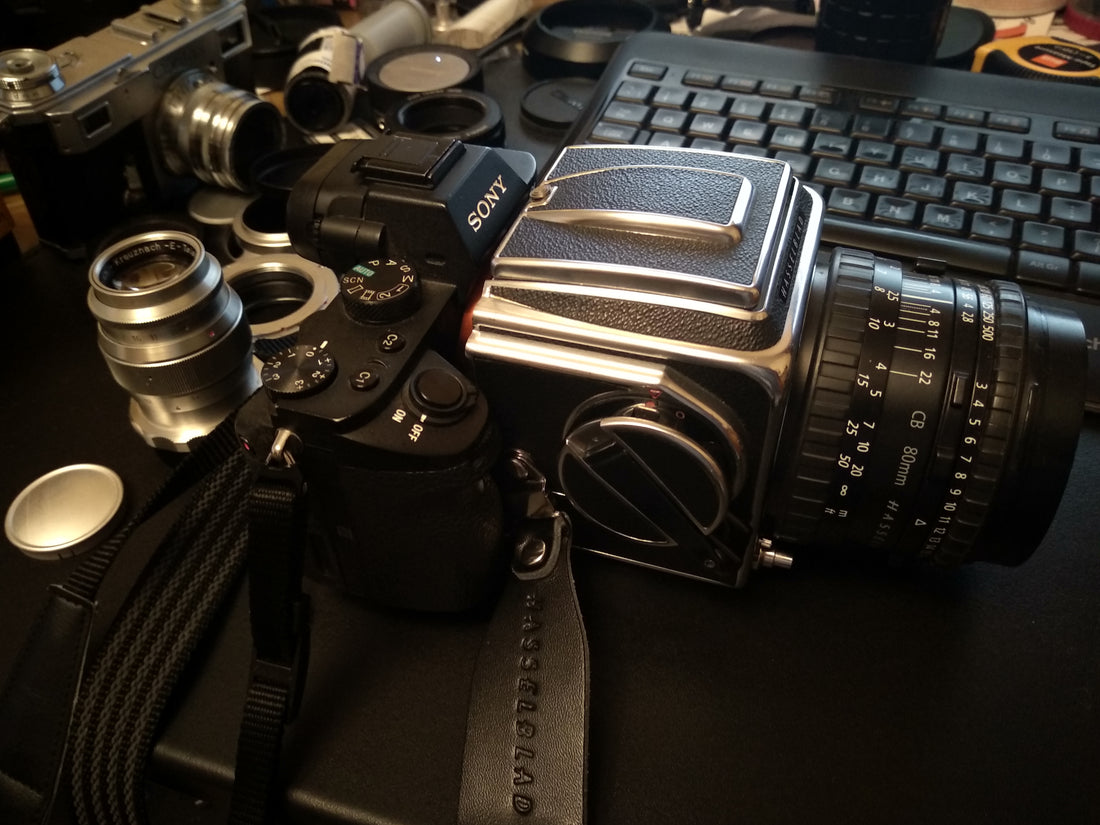
That time I made the Sonblad - The Poor Man's Hasselblad CFV II

Many of us have the irrational desire to use our cherished film cameras with the convenience and instant gratification of a digital sensor. I've long been convinced that my Contax RX would be devastatingly effective as a DSLR but science has not kept pace with my imagination. Economists suggest that the return on the investment required to integrate a 24mp Back Side Illuminated sensor with In Body Image Stabilisation into my Contax would be prohibitive because the RX is something of a niche camera. The final nail in the coffin is the fact that the tiny LCD panel on the top plate of my Contax is starting to bleed so who knows how long it will plough on.
Having been reconciled to never having my dream come true, those Swedes in Gothenburg have not only reignited my dream, but they have created an acceptable alternative to my digital RX with their CFV II digital back. A digital back for V Series cameras is not new, hence the "II" nomenclature of the new CFV, however, the fact that they've done it in 2019 is a huge shot in the arm for Hassy users and the analogue community in general. The new back acknowledges the increasing interest the analogue market and the growth in hybrid shooting in general.
I mentioned economics earlier, and alas this is where things start to fall down for me as a 50mp (4:3 ratio) back from Hasselblad is simply going to be way out of my budget. Prices have yet to be announced, but bear in mind that after I mentioned on a recent episode of the Classic Lenses Podcast that I could not afford to shoot Kodak Portra, someone took pity on me and donated a roll...
So, having seen Hasselblad's new promotional video where a successful architect (I assume) leaves his record player on as he leaves his house (presumably to confuse potential burglars) and gets into his classic electric Ford Mustang (because they don't make Saabs anymore), I realised I had the means to make my own digital back.
Ladies and gentleman, I give you the Sonblad:
 A Sonblad in action, yesterday
A Sonblad in action, yesterday
The carefully selected focal flange distance of the Sonblad makes it something of a specialised tool as it's optimised for that most worthy of subjects, flower bokeh photography. The images I've shared here were taken at infinity and of course, wide open so we can best see the character of the 80mm Planar.

Mmm, smooth bokeh
Using the Sonblad is simplicity itself, just set the Hassy shutter to bulb mode, press and hold the shutter whilst holding the denuded Sony to the now open rear end of the Hassy.
NOTE. Some care has to be taken in how the two cameras are held as it is quite awkward to hold both cameras and have control of both shutter buttons without dropping either camera. It's possible to lock the shutter button in the fired position and this makes handling a little easier.
Other pro tips include turning on the Sony before mating, as it becomes awkward to do this once the cameras being held together. You may wish to flip out the rear LCD panel to make low level work easier or to use as a corrected waist level finder and don't forget to set the IBIS on the Sony to the correct focal length to get all of that stabilised goodness.

Stopping down for appropriate depth of field? And loose some character? No thanks!
Future developments of the Sonblad will feature masking tape and string to create a bond between the two bodies and to eliminate the substantial gap that's formed between the mount of the Sony and the rear of the Hassy. Despite the light gap, the images still have excellent contrast.

Use your Sonblad to befuddle your subject
Should this article raise sufficient interest, I will, of course, create a Kickstarter campaign to raise capital to create an injection moulded housing to better integrate the two systems. All the proceeds will go to creating a digital back for my RX.
For more nonsense from me just download the Classic Lenses Podcast each Monday with Johnny Sisson & Perry Ge - www.classiclensespodcast.com
And for some large format nonsense with Andrew Bartram, then head over and listen to us on the Large Format Photography Podcast - LFPP
This blog post was originally written for and published by www.35mmc.com

